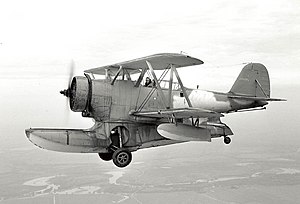J2F-5 Duck
| J2F Duck | |
|---|---|
 |
|
| Grumman J2F-4 Duck in flight | |
| Role | Utility amphibian |
| National origin | United States |
| Manufacturer |
Grumman Columbia Aircraft Corp |
| First flight | 1936 |
| Introduction | 1936 |
| Primary users |
United States Navy United States Army Air Forces United States Coast Guard United States Marine Corps |
| Number built | 584 |
| Developed from | Grumman JF Duck |
The Grumman J2F Duck (company designation G-15) was an American single-engine amphibious biplane. It was used by each major branch of the U.S. armed forces from the mid-1930s until just after World War II, primarily for utility and air-sea rescue duties. It was also used by the Argentine Navy, who took delivery of their first Duck in 1937. After the war, J2F Ducks saw service with independent civilian operators, as well as the armed forces of Colombia and Mexico.
The J2F was an improved version of the earlier JF Duck, with its main difference being a longer float.
The J2F-1 Duck first flew on 2 April 1936, powered by a 750 hp (559 kW) Wright R-1820 Cyclone, and was delivered to the U.S. Navy on the same day. The J2F-2 had a Wright Cyclone engine which was boosted to 790 hp (589 kW). Twenty J2F-3 variants were built in 1939 for use by the Navy as executive transports with plush interiors. Due to pressure of work following the United States entry into the war in 1941, production of the J2F Duck was transferred to the Columbia Aircraft Corp of New York. They produced 330 aircraft for the Navy and U.S. Coast Guard. If standard Navy nomenclature practice had been followed, these would have been designated JL-1s, but it was not, and all Columbia-produced airframes were delivered as J2F-6s.
Several surplus Navy Ducks were converted for use by the United States Air Force in the air-sea rescue role as the OA-12 in 1948.
...
Wikipedia
